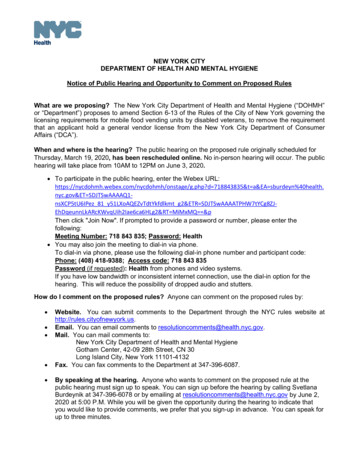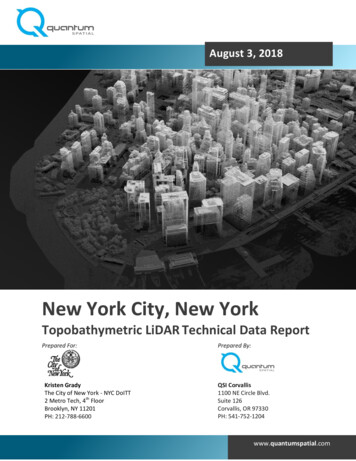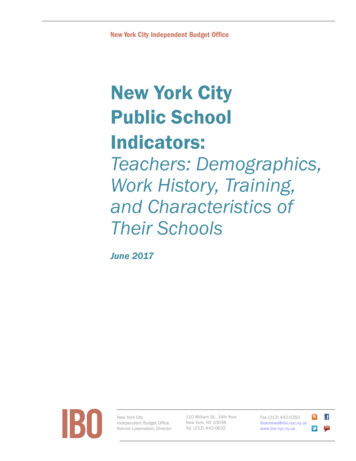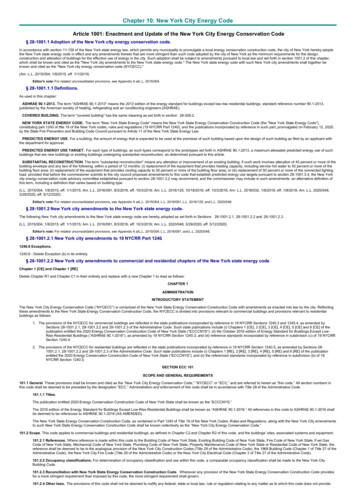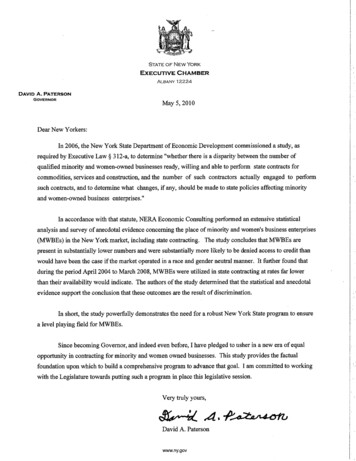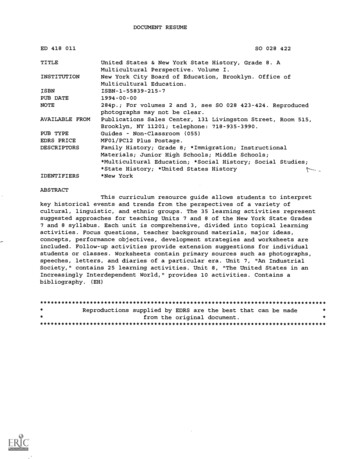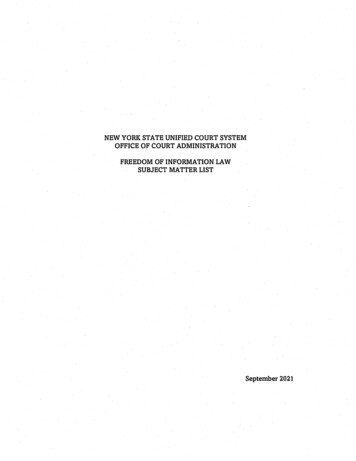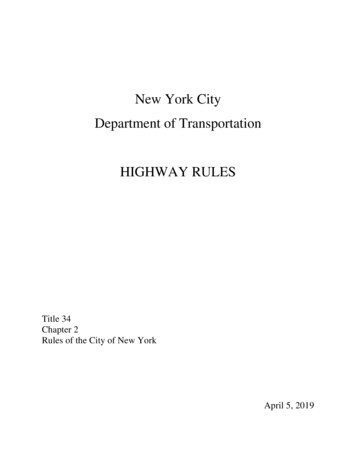
Transcription
New York CityDepartment of TransportationHIGHWAY RULESTitle 34Chapter 2Rules of the City of New YorkApril 5, 2019
Title 34Department of TransportationChapter 2Highway Rules04/05/19CONTENTS§ 2-01 Definitions§ 2-01.1 Compliance with the Manual on Uniform Traffic Devices§ 2-02 Permits(a) Initial permit application(b) General conditions for all permits(c) Display of permits and signs at worksite(d) Corrective action request(e) Orders(f) Fees(g) Notice of street operations(h) Work site safety(i) Waivers(j) Suspension of application review(k) Permit revocation and refusal to renew permit(l) Refusal to issue permit(m) Embargo periods(n) Voiding and reissuing of permits§ 2-03 Schedule of fees§ 2-04 Canopies(a) Permit required(b) Permit fees(c) Conditions(d) Maintenance(e) Permit expiration, renewal and transferability(f) Placement of canopies(g) Design criteria(h) Application(i) Removal of unauthorized canopies(j) Miscellaneous§ 2-05 Construction activity(a) Permit required(b) Permit requirements(c) Conditions(d) Conditions for the placement or storage of construction material andequipment (other than cranes) on the street(e) Temporarily closing sidewalk(f) Temporary pedestrian walkway in roadway(g) Temporarily closing roadway(h) Placement of shanties or trailers on the streeti
(i) Crossing a sidewalk(j) Placement of cranes and derricks on street(k) Format to be used for irrevocable stand-by letter of credit(l) Crane restricted area(m) Pedestrian Traffic Managers§ 2-06 Land contour work(a) Permit required(b) Conditions(c) Exceptions(d) Application(e) Approval required§ 2-07 Underground street access covers, transformer vault covers, and gratings(a) General conditions(b) Maintenance requirements(c) Work in critical roadways§ 2-08 Newsracks(a) Definitions(b) Placement(c) Unlawful locations(d) Size, shape and appearance(e) Maintenance(f) Indemnification and insurance(g) Violations and removal(h) Notices§ 2-09 Sidewalk, Curb and Roadway Work(a) Compliance with requirements(b) Professional self-certification(c) Coordination with capital projects – all city, state and federal agencies andpublic authorities(d) Required submissions(e) Waiver(f) Sidewalk(g) Curb (concrete, steel faced, stone)(h) Roadway§ 2-10 Temporary Installations for Flood Mitigation and Security Purposes(a) Permit required(b) Permit requirements(c) Definitions(d) Temporary Security Structures(e) Flood Mitigation Systems§ 2-11 Street openings and excavations(a) Permit required(b) Permit requirements(c) Conditions(d) Applicationii
(e) Excavation and restoration requirements(f) Excavations and street openings in protected streets(g) Emergency street openings and excavations§ 2-12 Vacant lots(a) Property owners' responsibility(b) Failure to comply(c) Reinspection(d) Permit requirements§ 2-13 Vaults(a) Vault defined(b) Exceptions(c) License required(d) Permit required(e) Applications(f) Adjustments to license fee(g) Limitations(h) Curb(i) Arched or covered vault(j) Hoistway openings(k) Boiler room exit(l) Sidewalks over vaults(m) Doors and gratings(n) Defective covers(o) Abandoned vaults(p) Historic districts§ 2-14 Miscellaneous(a) Public pay telephones(b) Banners(c) Bandstands and temporary platforms(d) Helicopter lifts(e) Temporary festoon/holiday lighting and/or other temporary lighting(f) Commercial refuse containers(g) Storage boxes(h) No smoking in pedestrian plazas(i) Flagpole sockets§ 2-15 Removal of unauthorized encroachments§ 2-16 Street closings lasting more than 180 days§ 2-17 Adjudications§ 2-18 Newsstands§ 2-19 Bicycle access in office buildings(a) Definitions(b) Bicycle access plan(c) Amendments to planiii
(d) Exceptions(e) Inspection and determination(f) Posting(g) Filing of bicycle access plan and subsequent amendments with the Department§ 2-20 Street Light and Power(a) General requirements(b) Shunts: overhead, street and wrap-around shunts(c) Electrical traffic control devices(d) Cable guards and standpipes/overhead wiring(e) Conductors-Aerial/Overhead(f) Cross arms(g) Electrical construction(h) [Intentionally left blank](i) Overhead distribution structures(j) Equipment and equipment repairs(k) Conduits(l) Grounding(m) Work site safety(n) Guys and anchors(o) [Intentionally left blank](p) Insulators(q) Pole installations(r) Persons installing, relocating, removing/replacing street light poles and/orinstalling/removing temporary pole taps(s) Service conductors, supply or communication(t) Service connections for exterior electrical installation(u) [Intentionally left blank](v) Supports(w) Tests, including stray voltage tests(x) Transformers and cable boxes(y) Vertical supply conductors§ 2-21 Adopt-a-Highway Program(a)Purpose(b)Definitions(c)General Requirements(d)Permits(e)Levels of service(f)Work areas(g)Sponsors and maintenance providers(h)Volunteers(i)Changing adopted segments(j)Reserving segments(k)Sharing segments(l)Adopt-a-Highway Signs(m)Field inspections of adopted segments(n)Voiding and revoking permits§ 2-22 Adopt-a-Greenway Program(a) Purposeiv
(b) Definitions(c) General Requirements(d) Permits(e) Levels of service(f) Work areas(g) Sponsors and maintenance providers(h) Volunteers(i) Changing adopted segments(j) Reserving segments(k) Sharing segments(l) Adopt-a-Greenway Signs(m) Field inspections of adopted segments(n) Voiding and revoking permits§ 2-23 Microtrenching(a) Incorporation(b) Microtrenchingv
Section 2-01DEFINITIONSAdministrative Code. The term "Administrative Code" means the Administrative Code of the Cityof New York.Block Segment. The term "Block Segment" means the linear stretch of the street between thecurblines of the cross streets that intersect such block.City Electrical Equipment. The term "city electrical equipment" means city property to whichelectrical connections can be made, including but not limited to, electrical devices, wood poles andmetal street light/lampposts.City Property. The term "city property" means, for the purpose of this section, real property andphysical structures owned by the City of New York and subject to Department of Transportationjurisdiction, including but not limited to, roadways, sidewalks, street furniture and electricalequipment.Commissioner. The term "Commissioner" means the Commissioner of the Department ofTransportation or his or her authorized designee.Corrective action request or CAR. The term "corrective action request" or "CAR" means a formalnotice by the Department that work performed and/or a condition created or maintained on a streetis in violation of these rules or other applicable law with a request that action be taken by theperson to whom such notice is addressed to correct the work and/or the condition so described.Department. The term "Department" means the Department of Transportation.Designated field headquarters. The term "designated field headquarters" means an officemaintained at the work site, unless some other location is approved by the Department.Embargo period. The term "embargo period" means a period of time designated by the OCMCduring which there shall be a temporary suspension of work (except for emergency work) due to aholiday, special event or emergency.Emergency. The term "emergency" means a situation endangering the public safety or causing orlikely to cause the imminent interruption of service required by law, contract or franchise to becontinuously maintained.Emergency work. The term "emergency work" means work necessary to correct a situationendangering the public safety or causing or likely to cause the imminent interruption of servicerequired by law, contract or franchise to be continuously maintained, for example, by a governmentagency, a public utility, a franchisee, etc. Such term shall not include work on new construction,regrades of existing hardware, continuation of an existing permit that has expired or will expireimminently or any other work which is not necessary to correct a condition likely to cause suchimminent interruption.Intersection. The term "Intersection" means the area contained within the grid created byextending the curblines of two or more streets at the point at which they cross each other.Non-city Electrical Equipment. The term "non-city electrical equipment" means property, notowned by the City, which is attached to City Property and to which electrical connections can bemade, including but not limited to, electrical devices and wood poles.1
Section 2-01OCMC. The term "OCMC" means the Office of Construction Mitigation and Coordination, a unitwithin the Department which is responsible for providing traffic stipulations and coordinatingconstruction activity on City streets.Overhead shunt. The term "overhead shunt" means a shunt that runs from the top of a street lightor traffic control device pole to another pole and/or to a property.Pedestrian Traffic Manager. The term "pedestrian traffic manager" means a person authorized bythe Commissioner to direct bicycle and pedestrian traffic pursuant to these rules.Permittee. An individual, corporation, business or other entity who secures permits for all workregulated by the Department, pursuant to these rules.Person. The term "person" means a natural person, partnership, corporation, limited liabilitycompany, association or any other entity.Protected street. The term "protected street" means a street which has been resurfaced orreconstructed within five years prior to the date of application for a permit.Public Utilities. The term "public utilities" means public utility companies as defined in the PublicService Law.Roadway. The term "roadway" means that portion of a street designed, improved or ordinarilyused for vehicular travel, exclusive of the shoulder and slope.Shunt. The term "shunt" means a temporary electrical cable or conduit that has been installedbetween two points to divert current from one path, which is no longer in use, to another path.Sidewalk. The term "sidewalk" means that portion of a street between the curb lines, or the laterallines of a roadway, and the adjacent property lines, intended for the use of pedestrians.Standard Specifications. The term “Standard Specifications” means the most recent version ofthe standard highway specifications available from the Department and the New York CityDepartment of Design and Construction indicating required construction materials.Standard Detail Drawings. The term “Standard Detail Drawings” means the most recent versionof the standard details of construction, available from the Department and the New York CityDepartment of Design and Construction, which contains drawings showing required dimensions ofitems to be constructed.Street. The term "street" means a public street, avenue, road, alley, lane, highway, boulevard,concourse, parkway, driveway, culvert, sidewalk, crosswalk, boardwalk, viaduct, square or place,except marginal streets.Street shunt. The term "street shunt" means a shunt that runs from a street light/lamppost or utilityaccess cover along a roadway and/or sidewalk to a property or other street light/lamppost.Wrap-around shunt. The term "wrap-around shunt" means a shunt used on a street light/lamppostor traffic signal pole that is attached to the top of the pole, is looped or wrapped around the outsideof the pole and enters the base of the pole for electrical connection.2
Section 2-01.1COMPLIANCE WITH THE MANUAL ON UNIFORM TRAFFIC DEVICESAll permittees must comply with the most recent version of the Manual on Uniform TrafficControl Devices for Streets and Highways (MUTCD), published by the Federal HighwayAdministration (FHWA), and the New York State Supplement.3
Section 2-02PERMITS(a) Initial permit application. The following information shall be provided to the Department uponinitial application for a permit under these rules and shall be updated as necessary and refiledannually:(1) If the applicant is a corporation, limited liability corporation, limited liabilitypartnership or other entity registered with the New York Secretary of State:(i) address and telephone number of applicant;(ii) name and telephone number of a contact person in the event of an emergency;(iii) affidavit acknowledging incorporation and a certified copy of the certificate ofincorporation, and proof of registration with the New York State Department of State, Officeof the Secretary of State. When completing the permit application, applicants must supplythe Department with the identical identifying information, including but not limited to thecompany name, as they have provided to the New York State Department of State, Officeof the Secretary of State;(iv) names of corporate officers;(v) names of two agents/employees designated to receive summonses or notices ofviolation or other notices required by these rules or other provisions of law;(vi) New York City plumber's license certificate or other license numbers, if applicable;(vii) name(s) of representative(s) authorized to obtain permit(s) on behalf of the applicant;(viii) employer identification number;(ix) e-mail address, if any.(2) All other applicants:(i) address and telephone number of applicant;(ii) name(s) of representative(s) authorized to obtain permit(s) on behalf of the applicant;(iii) New York City plumber's license certificate or other license numbers, if applicable;(iv) employer identification number;(v) e-mail address, if any;(vi) names of two agents/employees designated to receive summonses or notices ofviolation or other notices required by these rules or other provisions of law.(3) Insurance and indemnification requirements (for all applicants):(i) Each applicant shall, before applying for a permit, obtain a Commercial General Liability(CGL) insurance policy or policies satisfying the requirements of this subparagraph. All CGLinsurance policies, whether primary, excess or umbrella, shall:(A) be issued by a company or companies that may lawfully issue the requiredpolicy and has an A.M. Best rating of at least A-VII or a Standard and Poor's ratingof at least AA.(B) provide coverage to protect the City of New York ("City") and the applicant fromclaims for property damage and/or bodily injury, including death, which may arisefrom any operations performed by or on behalf of the applicant for which theDepartment has issued it a permit;(C) provide coverage at least as broad as that provided by the most recent edition ofISO Form CG 0001;(D) provide coverage for completed operations;(E) provide coverage of at least 1,000,000 combined single limit per occurrence,except that with respect to applications for permits to place a crane on a street, suchminimum amount shall be no less than 3,000,000 combined single limit peroccurrence;4
Section 2-02(F) provide that the City and its officials and employees are Additional Insureds withcoverage at least as broad as set forth in ISO Form CG 2026 (11/85 ed.);(G) provide that the limit of coverage applicable to the Named Insured is equallyapplicable to the City as Additional Insured.(H) This policy shall not be cancelled or terminated, or modified or changed in a waythat affects the City by the issuing insurance company unless thirty (30) days priorwritten notice is sent to the Named Insured and the Commissioner of the New YorkCity Department of Transportation, except that notice of termination for nonpayment may be made on only ten (10) days written notice.(I) If the permit applicant has applied for more than one thousand permits in theprevious calendar year, the insurance policy shall contain each of the followingendorsements;(1) If and insofar as knowledge of an "occurrence", "claim", or "suit" isrelevant to the City as Additional Insured under this policy, such knowledgeby an agent, servant, official or employee of the City of New York will not beconsidered knowledge on the part of the City of the "occurrence", "claim", or"suit" unless notice thereof is received by the: Insurance Claims Specialist,Affirmative Litigation Division, New York City Law Department; and(2) Any notice, demand or other writing by or on behalf of the Named Insuredto the insurance company shall also be deemed to be a notice, demand orother writing on behalf of the City as Additional Insured. Any response by theInsurance Company to such notice, demand or other writing shall beaddressed to the Named Insured and to the City at the following address:Insurance Claims Specialist, Affirmative Litigation Division, New York CityLaw Department, 100 Church Street, New York, New York 10007.(ii) Each applicant shall, before applying for a permit, obtain Workers Compensationinsurance in accordance with the laws of the State of New York from a licensed insurancecompany.(iii) Each applicant shall, before applying for a permit, file with the Department proof thatthe applicant has insurance in place that provides coverage set forth in this subdivision withrespect to the permit period. If the applicant chooses to meet this proof with an insurancecertificate, the insurance certificate shall set forth the coverage provided, state thatcompleted operations coverage is included and that the City is an additional insured, andshall be accompanied by a sworn statement in a form prescribed by the Department fromthe insurer or from a licensed insurance broker certifying that the insurance certificate isaccurate in all material respects, and that the described insurance is in effect.(iv) An applicant may obtain insurance policies applicable to more than one permitapplication, in which case the proof pursuant to subparagraph (iii) shall state that thepolicies cover all such permits in specified boroughs, or throughout the City.(v) The applicant shall provide a copy of any required policy within thirty days of a requestfor such policy by the Department or the New York City Law Department.(vi) In its sole discretion, the Department may allow applicants that frequently seek permitsto self-insure, provided that the applicant:(A) presents proof of excess or umbrella CGL coverage applicable to its operationsunder such permits;(B) certifies that it has a self-insurance program in place that satisfies therequirements contained in subparagraph (i) and will continue it for the life of thepermit and the Guarantee Period, as defined in subparagraph (ii) of paragraph (16)of subdivision (e) of §2-11 of these rules;5
Section 2-02(C) agrees to provide the same defense of any suit against the City that allegesfacts that bring the suit within the scope of the coverage required in subparagraph (i)as an insurer would be obligated to provide under the laws of New York;(D) submits a statement, signed by a person authorized to bind the applicant andacknowledged by a notary public, in which the applicant agrees to assume fullliability for satisfying all obligations set forth in this subparagraph (vi), and(E) provides the Department with the name and address of the office or official of itsself-insurance program who is responsible for satisfying the self-insuranceobligations.(vii) The permittee shall maintain insurance throughout the Guarantee Period, as defined insubparagraph (ii) of paragraph (16) of subdivision (e) of §2-11 of these rules, satisfying therequirements in subparagraph (i) of this paragraph and providing coverage to protect theCity, the Department and the applicant from all claims for property damage and/or bodilyinjury, including death, which may arise from any defects discovered during suchGuarantee Period.(viii) The permittee shall notify in writing the CGL insurance carrier, and, where applicable,the worker's compensation and/or other insurance carrier, of any loss, damage, injury, oraccident, and any claim or suit arising from any operations performed by or on behalf of thepermittee for which the Department has issued it a permit, immediately, but not later than20 days after such event. The permittee's notice to the CGL insurance carrier mustexpressly specify that "this notice is being given on behalf of the City of New York asAdditional Insured as well as the Named Insured." The permittee's notice to the insurancecarrier shall contain the following information: the name of the permittee, the number of thepermittee, the date of the occurrence, the location (street address and borough) of theoccurrence, and the identity of the persons or things injured, damaged or lost.(ix) The permittee shall indemnify, defend and hold the City and its officials and employeesharmless against any and all claims, liens, demands, judgments, penalties, fines, liabilities,settlements, damages, costs and expenses of whatever kind or nature (including, withoutlimitation, attorneys' fees and disbursements), known or unknown, contingent or otherwise,allegedly arising out of or in any way related to the operations of the permittee and/or itsfailure to comply with any of the requirements set forth herein or law. Insofar as the factsand law relating to any claim would preclude the City and its officials and employees frombeing completely indemnified by the permittee, the City and its officials and employees shallbe partially indemnified by the permittee to the fullest extent provided by law.(x) A failure by the City of New York or the Department to enforce any of the foregoingrequirements shall not constitute a waiver of such requirement or any other requirement.(4) Permit bonds.(i) A permit bond shall be submitted by all permittees to the permit office at the time ofpermit issuance to cover all costs and expenses that may be incurred by the City as a resultof the activity for which the permit is issued or for the purpose of otherwise safeguarding theinterests of the City. The permit bond shall be in the form prescribed by the Department.Such permit bonds described above shall cover all permitted activities described herein.(ii) For a permit bond submitted for the purpose of performing street openings andexcavations pursuant to §2-11 of these rules, such permit bond shall be submitted in theamount of 10,000.00 for a single location within the City of New York per calendar year, 50,000.00 for two to fifty locations within the City of New York per calendar year, and 100,000.00 for fifty-one to one hundred locations within the City of New York per calendaryear. Permittees who are issued permits for more than one hundred locations per calendaryear shall submit a permit bond in the amount of 250,000.00.(iii) Bonds shall be valid through the permit's guarantee period as set forth in these rules.6
Section 2-02(iv) The issuer of the bond shall give the Department at least 30 days written notice prior toexpiration or cancellation of such bond.(v) A receipt demonstrating full payment of the bond shall be filed with the Department.(vi) A separate bond need not be filed for each location, provided such coverage is in forcefor all operations in the entire borough, City or state.(vii) A notice of continuation of certificate shall be received every calendar year for thecontinuation of an existing bond.(viii) For permits with the exception of those set forth in subparagraph (ii) above andsidewalk construction permits issued pursuant to §2-09 of these rules, a permit bond shallbe submitted in the amount of 5,000 for a single location within the City of New York percalendar year or in the amount of 25,000 for multiple locations within the City of New Yorkper calendar year. In the event that a permittee will also secure street opening andexcavation permits within the City of New York during the same calendar year, thepermittee's compliance with subparagraph (ii) above shall be sufficient to demonstratecompliance with this section.(5) Deposits.(i) A deposit of 5,000.00, in the form of money order or certified check, shall be requiredfrom permittees when outstanding balances for permit fees, backcharge fees, correctiveaction requests (CARs) or other charges exceed 3,000.00 for a period longer than fortyfive (45) calendar days.(ii) Such permittees shall maintain a deposit balance of 5,000.00 at all times until thedeposit is refunded pursuant to subparagraph (iv), below. If the balance of such cashdeposit falls below 5,000.00, all review of permit applications and permit issuance maycease, except in cases of emergency work.(iii) Any amounts owed by permittees for permit fees, CAR fees, backcharge fees or othercharges payable pursuant to law for a period longer than forty-five (45) calendar days shallbe deducted from the deposit after notice to the permittee.(iv) Deposits shall be refunded after one year (365 consecutive calendar days) of fullcompliance with all applicable laws, rules and specifications.(b) General conditions for all permits.(1) Permit applications for the following work shall be reviewed by OCMC prior to the issuanceof permits:(i) work to be performed for sewer and water system construction;(ii) work to be performed in Manhattan;(iii) work required on primary and secondary arteries;(iv) permits to close streets;(v) any other activity deemed necessary by the Commissioner.(2) Permits for emergency work. Permits for emergency work shall be issued in accordancewith §2-11 of these rules.(3) Before issuing a permit the Department may demand that permittee show proof of requiredapprovals from other governmental entities.(4) Street closings lasting more than 180 days. Permits that will result in a publicly mappedstreet being fully closed for more than 180 consecutive calendar days shall be issued inaccordance with all the requirements of §2-16 of these rules.(c) Display of permits and signs at work site.(1) Unless otherwise authorized, permits shall be kept at the work site or designated fieldheadquarters at all times and shall be made available for inspection upon request of any policeofficer or any authorized employee of the Departments of Environmental Protection, Buildings,Police and Transportation or any other City employees specifically authorized by the7
Section 2-02Commissioner to enforce these rules. Such permits cannot be posted on construction fences,sidewalk sheds, construction containers or any other construction equipment.(2) Signage along series of excavations or street openings.(i) Permittees must post signs at 100 foot intervals along a series of excavations orcontinuous cut, indicating the following:(A) the name of the permittee conducting the work;(B) the name of the entity for whom the work is being conducted;(C) the name(s) of the subcontractor(s);(D) the permittee's telephone number for complaints;(E) the contractor's telephone number, if not the permittee;(F) the permit number;(G) the purpose of the excavation or street opening; and(H) the start and scheduled completion dates of the work.(ii) Such signs must be conspicuously displayed and face the nearest curb line. Such signsmust be easily visible and readable by pedestrians, and must conform to the Department'srequirements.(3) Construction Project Informational Signs. Permittees must post Construction ProjectInformational Signs for any project with a projected completion time of three months or more, oras otherwise directed by the Commissioner.(i) At least on Construction Project Informational Sign must be posted on each blocksegment where the project is located, and must be easily visible and readable by pedestrians,unless otherwise directed by the Commissioner. The sign(s) must be kept in good condition,and must conform with the Construction Project Information Sign requirements available at theDepartment’s Permit Offices and on the Department’s website.(ii) Such signs must contain the following information:(A) the names of the entities responsible for the project, including but not limited to thecontractor, developer, and property owner;(B) the telephone number, email address, and website for such entities responsible forthe project;(C) the name of the project and the project number (if any);(D) the address of the project;(E) the nature of the project;(F) a brief description of the project; and(G) the start and scheduled completion dates of the project.(iii) Construction Project Informational Signs are not required for any construction ordemolition project requiring a New York City Department of Buildings permit and whose site isenclosed with a fence or contains a sidewalk shed. Such signs must comply with theapplicable requirements of the New York City Building Code and the rules of the New York CityDepartment of Buildings.(d) Corrective action request (CAR).(1) A CAR may be served either personally, by mail and/or by e-mail on the person responsiblefor the work and/or the condition which requires correction at his or her last known address, email address or at the address or e-mail address for such person contained in the records ofthe Department. Where a CAR is served for a violation of §19-147 of the Administrative Code,in the case of a utility company, the CAR may be given orally or in writing to a person or at aplace designated by the utility and the utility shall respond within twenty-four (24) hours.(2) Any corrective action required by the CAR shall be performed within thirty (30) days of theissuance of the CAR unless such issuance is protested as provided herein.(3) Within fourteen (14) days after the date of mailing of the CAR, unless a different time isspecified on the CAR or in these rules, the respondent may protest the issuance of the CAR in8
Section 2-02the manner directed on the CAR. If a protest is timely submitted and granted by theDepartment, the CAR fee will be waived.(4) Protests shall be reviewed by the Department and a final determination regarding theprotest shall be made within a reasonable period of time.(5) If a protest is denied, any corrective action required by the CAR shall be performed withinthirty (30) days after the date of such denial.(6) In the event that the original permit has expired before the corrective action is undertakenand an additional excavation is necessary, a new permit shall be obtained in order to completethe required work. The new permit s
New York City . Department of Transportation . HIGHWAY RULES . Title 34 . Chapter 2 . Rules of the City of New York . April 5, 2019 . i . Indemnification and insurance (g) Violations and removal (h) Notices § 2-09 Sidewalk, Curb and Roadway Work (a) Compliance with requirements


